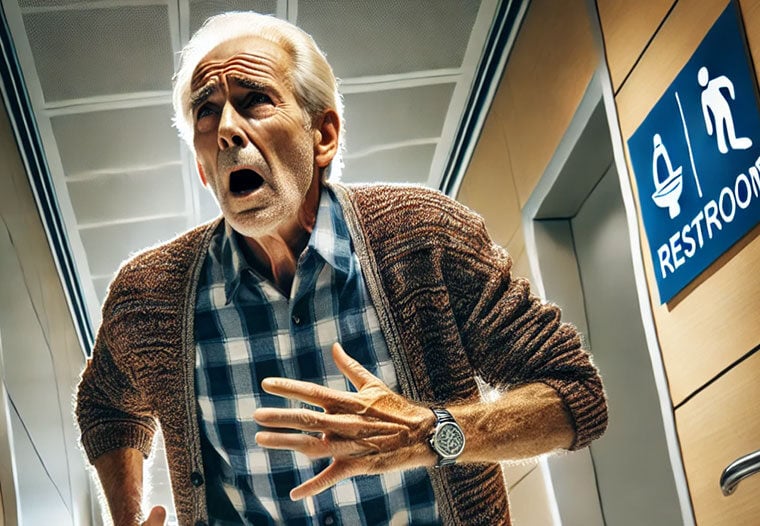Functional Disorders of the Lower Urinary Tract in Parkinson’s Disease: A Guide for Male Patients

Parkinson’s disease (PD) is an extrapyramidal neurological disorder primarily recognized for its motor symptoms, such as tremors, rigidity, and bradykinesia. However, non-motor symptoms, including lower urinary tract dysfunction, are increasingly acknowledged as significant contributors to reduced quality of life. Research indicates that 57–83% of PD patients experience urinary storage symptoms, while voiding dysfunction affects 17–27% of individuals. Among these, nocturia is the most prevalent, impacting over 60% of patients, followed by urgency (33–54%) and frequency (16–36%).
Introduction
The underlying cause of urinary dysfunction in PD is neurogenic detrusor overactivity (DO), which affects 45–93% of patients. This condition leads to involuntary bladder contractions, causing urgency, frequent urination, and, in severe cases, incontinence. While lower urinary tract symptoms (LUTS) in PD are often attributed to disease-related autonomic dysfunction, differential diagnoses such as Multiple System Atrophy (MSA) must be considered. MSA presents with nearly universal urinary dysfunction, often leading to misdiagnosis in early stages.
Given the significant impact of urinary disturbances on daily life, timely diagnosis and management are essential. Urodynamic studies, including cystometry and flowmetry, help distinguish between different causes of LUTS. Addressing these symptoms not only improves quality of life but also reduces complications such as infections and sleep disturbances, making urinary management a critical aspect of PD care.
Mechanisms Behind Urinary Dysfunction in Parkinson’s Disease
Parkinson’s disease (PD) affects the nervous system in ways that go beyond movement difficulties—it also impacts bladder control. The brain plays a crucial role in regulating urination, and research using functional imaging has shown that dopamine, a key neurotransmitter, is essential for normal bladder function. When dopamine levels decrease in PD, communication between the brain and bladder becomes disrupted, leading to urinary symptoms such as urgency, frequent urination, and nocturia (waking up multiple times at night to urinate).
One of the main issues in PD-related bladder dysfunction is neurogenic detrusor overactivity (DO). The detrusor muscle in the bladder is responsible for contracting and releasing urine at the right time. However, in many PD patients (45–93%), this muscle becomes overactive, causing sudden, strong urges to urinate, often leading to leakage (urge incontinence). Additionally, some patients may struggle with bladder emptying, leading to a weak stream or the feeling of incomplete voiding.
The autonomic nervous system (ANS), which controls involuntary body functions, is also affected by PD. This disruption further contributes to bladder problems, as the body loses its ability to properly regulate urination. While overactive bladder symptoms are the most common, some patients may experience a combination of urge incontinence and difficulty emptying the bladder, making symptoms more complex.
Since bladder dysfunction in PD is often overlooked, recognizing these issues early is essential for proper management. Understanding that these problems are caused by nerve dysfunction rather than simple aging can help patients seek the right treatment and improve their quality of life.
Common Urinary Symptoms in Male Parkinson’s Patients
Overactive Bladder (OAB): Urgency, Frequency, and Nocturia
Overactive bladder is the most prevalent urinary issue in PD, affecting between 57–83% of patients. It occurs due to detrusor overactivity (DO), where the bladder muscle contracts involuntarily. This leads to:
-
Urgency: A sudden, uncontrollable urge to urinate, often resulting in urge incontinence in 33–54% of PD patients.
-
Frequency: Needing to urinate more than 8 times per day, reported in 16–36% of PD patients.
-
Nocturia: Waking up multiple times at night to urinate, the most common urinary complaint in PD, affecting over 60% of patients.
Nocturia in PD is influenced by bladder hypersensitivity, reduced bladder capacity, nocturnal polyuria (excess urine production at night), cardiovascular dysautonomia, and circadian rhythm disruptions. Studies show that PD patients experiencing two or more nighttime voiding episodes have significantly poorer sleep quality, reduced REM sleep, and increased daytime fatigue.
Urinary Retention & Incomplete Emptying: Weak Stream and Hesitancy
While OAB symptoms dominate, 17–27% of PD patients also experience urinary retention, leading to:
-
Weak urine stream due to impaired bladder muscle contraction.
-
Hesitancy or delayed urine flow initiation.
-
Feeling of incomplete emptying, which can increase the risk of urinary tract infections (UTIs).
These symptoms arise due to the loss of coordination between the bladder and sphincter muscles, leading to functional obstruction despite the absence of physical blockage.
Mixed Symptoms: Fluctuating Between Urgency and Retention
Some PD patients alternate between urgency and retention, making management more challenging. This happens because the autonomic nervous system fails to regulate bladder activity properly, causing unpredictable bladder contractions and incomplete emptying.
Impact on Quality of Life, Sleep, and Social Interactions
Urinary symptoms in PD drastically reduce quality of life (QoL):
-
Sleep disturbances due to nocturia contribute to fatigue, depression, and cognitive decline. A Finnish study found that PD patients waking up twice or more per night had significantly poorer health-related QoL.
-
Increased fall risk: Nighttime bathroom trips in PD patients raise the risk of falls and fractures, especially in those with mobility issues.
-
Social withdrawal and emotional distress: Many patients limit social activities due to incontinence fears, leading to anxiety and depression.
Recognizing and addressing these symptoms early is crucial in improving both bladder health and overall well-being in male PD patients.

Diagnosis and Medical Evaluation
A thorough urological assessment is crucial in Parkinson’s disease (PD) to differentiate lower urinary tract symptoms (LUTS) from other urological conditions such as benign prostatic hyperplasia (BPH). Given the overlap with BPH, proper diagnostic evaluation is essential.
Key Diagnostic Tools
-
Urodynamic Studies – These tests help confirm detrusor overactivity (DO).Unlike multiple system atrophy (MSA), which leads to significant urinary retention, PD patients generally exhibit minimal post-void residual (PVR) volume.
-
Bladder Diaries – Patients document urinary habits, including frequency, urgency, and nocturia episodes, aiding in distinguishing PD-related bladder dysfunction from other causes.
-
Validated Questionnaires – Surveys assess the severity and impact of LUTS on quality of life (QoL).
Differentiating PD-Related LUTS from BPH
Both conditions can present with urgency, frequency, and nocturia. However, PD-related LUTS primarily result from disrupted dopaminergic control of bladder function, leading to detrusor overactivity. In contrast, BPH is characterized by prostate enlargement causing obstruction and incomplete emptying. A comprehensive evaluation, including urodynamic studies, flowmetry, and ultrasonography, is necessary before treatment initiation.
Given that PD-related LUTS significantly impact QoL and may contribute to falls and institutionalization, collaboration between neurologists and urologists is essential for tailored management strategies.
Treatment Strategies for Urinary Dysfunction in Parkinson’s Disease
Lifestyle Modifications
Behavioral changes are the first-line approach for managing urinary symptoms in PD. Patients are encouraged to maintain adequate hydration while avoiding excessive intake of bladder irritants such as caffeine, alcohol, and artificial sweeteners. Timed voiding, where patients urinate on a fixed schedule, helps mitigate urgency and incontinence. Bladder retraining techniques, which involve gradually increasing the time between voids, can also improve bladder control.
Pharmacological Management
Medication choices must balance efficacy with potential side effects, particularly cognitive impairment. Anticholinergic agents such as tolterodine, solifenacin, and darifenacin are effective for overactive bladder (OAB) but must be used cautiously due to their association with cognitive decline. Newer beta-3 adrenergic agonists like mirabegron provide an alternative with fewer cognitive side effects and have shown promising efficacy in PD patients.
Dopaminergic treatments, a cornerstone of PD management, can either improve or exacerbate urinary symptoms. Adjusting these therapies under the supervision of a neurologist is essential. For patients with urinary retention or inadequate bladder emptying, bethanechol may be beneficial, although intermittent self-catheterization is sometimes required.
Pelvic Floor Therapy & Bladder Training
Pelvic floor therapy, including Kegel exercises and the Knack maneuver, can strengthen bladder control and reduce incontinence episodes. Studies suggest that pelvic floor training significantly improves urinary symptoms in male PD patients, enhancing bladder storage function and reducing leakage episodes.
Catheterization & Surgical Options
In cases where conservative and pharmacologic treatments fail, invasive interventions may be necessary. Urodynamic testing, including cystometry and ultrasonography, should be performed to assess bladder function before proceeding with more advanced treatments.
Minimally invasive procedures such as percutaneous tibial nerve stimulation (PTNS) and botulinum toxin injections into the detrusor muscle have demonstrated efficacy in patients with refractory OAB. Sacral neuromodulation via the InterStim device has also shown promise in modulating bladder function. In severe cases, intermittent catheterization or indwelling catheters may be required to manage urinary retention.
Conclusion
Urinary dysfunction is a common yet often overlooked complication of Parkinson’s disease, significantly affecting quality of life, sleep, and daily activities. Early recognition and appropriate management, including lifestyle changes, medication, pelvic floor therapy, and, in some cases, advanced interventions, can help alleviate symptoms and improve bladder control.
Since urinary incontinence can be unpredictable, male PD patients should consider reliable absorbent solutions to maintain comfort and dignity.
For those experiencing frequent leaks or nocturia, absorbent pads like QuickChange Wraps offer an effective and convenient solution. For those seeking support, we invite you to purchase a 10 Count Trial Pack here or request a professional-use sample pack for healthcare institutions here.
References:
Jost, W. H. (2013). Urological problems in Parkinson's disease: Clinical aspects. Journal of Neural Transmission (Vienna), 120(4), 587-591. https://doi.org/10.1007/s00702-012-0914-8
Lee, C. L., & Kuo, H. C. (2017). Current consensus and controversy on the diagnosis of male lower urinary tract symptoms/benign prostatic hyperplasia. Tzu Chi Medical Journal, 29(1), 6-11. https://doi.org/10.4103/tcmj.tcmj_3_17
Liu, Z., Uchiyama, T., Sakakibara, R., & Yamamoto, T. (2015). Underactive and overactive bladders are related to motor function and quality of life in Parkinson's disease. International Urology and Nephrology, 47(5), 751-757. https://doi.org/10.1007/s11255-015-0951-y
Parkinson's Foundation. (n.d.). Urinary problems in Parkinson's disease. Parkinson's Foundation. https://www.parkinson.org/library/fact-sheets/urinary-problems
Sakakibara, R., Panicker, J., Finazzi-Agro, E., Iacovelli, V., Bruschini, H., Parkinson's Disease Subcommittee, & The Neurourology Promotion Committee in The International Continence Society. (2016). A guideline for the management of bladder dysfunction in Parkinson's disease and other gait disorders. Neurourology and Urodynamics, 35(5), 551-563. https://doi.org/10.1002/nau.22764
Winge, K., & Fowler, C. J. (2006). Bladder dysfunction in Parkinsonism: Mechanisms, prevalence, symptoms, and management. Movement Disorders, 21(6), 737-745. https://doi.org/10.1002/mds.20867
Yeo, L., Singh, R., Gundeti, M., Barua, J. M., & Masood, J. (2012). Urinary tract dysfunction in Parkinson's disease: A review. International Urology and Nephrology, 44(2), 415-424. https://doi.org/10.1007/s11255-011-9969-y
Zheng, Y., & Cameron, A. P. (2024). Sleep and overactive bladder in Parkinson’s disease. Urologic Clinics of North America, 51(2), 197-207. https://doi.org/10.1016/j.ucl.2024.02.005

